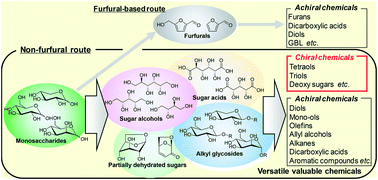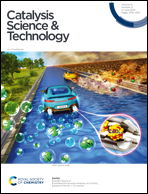Reduction of sugar derivatives to valuable chemicals: utilization of asymmetric carbons
Abstract
Biomass is a promising renewable resource substitute for petroleum, and transformation of biomass-derived materials to valuable chemicals is an urgent issue. To date, transformation methods of biomass-based materials via furfural and 5-hydroxymethyl furfural have been intensively developed, giving some important chemicals. However, considering the versatility of chemicals from petroleum, development of other transformation methods of biomass-derived materials is essential; in particular, transformation methods of biomass-derived materials which can make the most use of the unique structures is preferable. This perspective focuses on non-furfural routes of sugar derivatives, which are the main scaffolds of biomass-derived cellulose and hemicellulose, and it summarizes recent studies on catalytic transformations to valuable chemicals. These transformation routes are based on key reactions such as hydrogenolysis, reduction with silane reducing agents using borane catalyst, deoxydehydration (DODH) (+hydrogenation (HG)) and combination of dehydration and hydrogenation (and/or hydrogenolysis), and some of these transformation methods enable the synthesis of chiral products derived from the original sugars.

- This article is part of the themed collection: Catalysis for sustainable development


 Please wait while we load your content...
Please wait while we load your content...